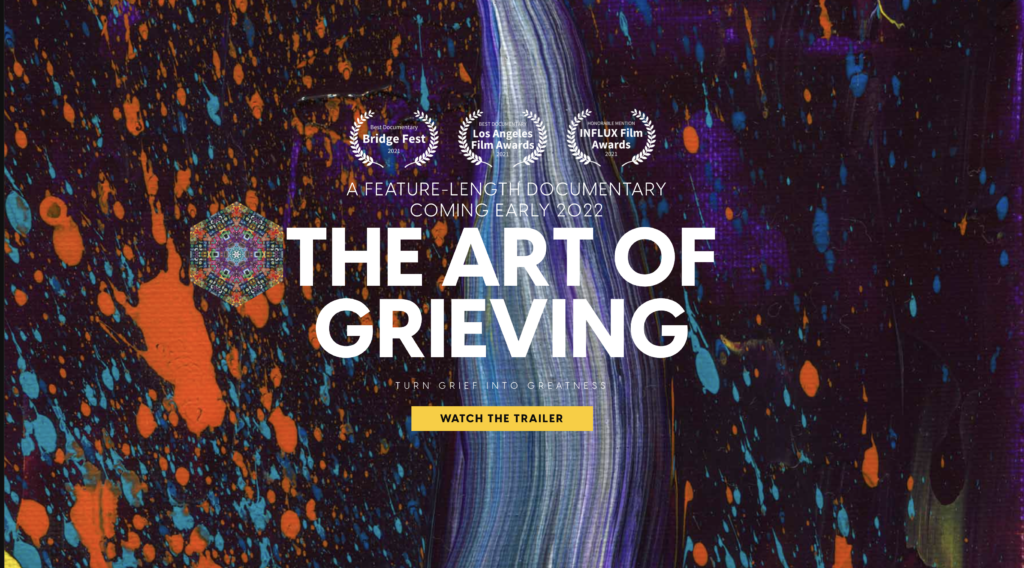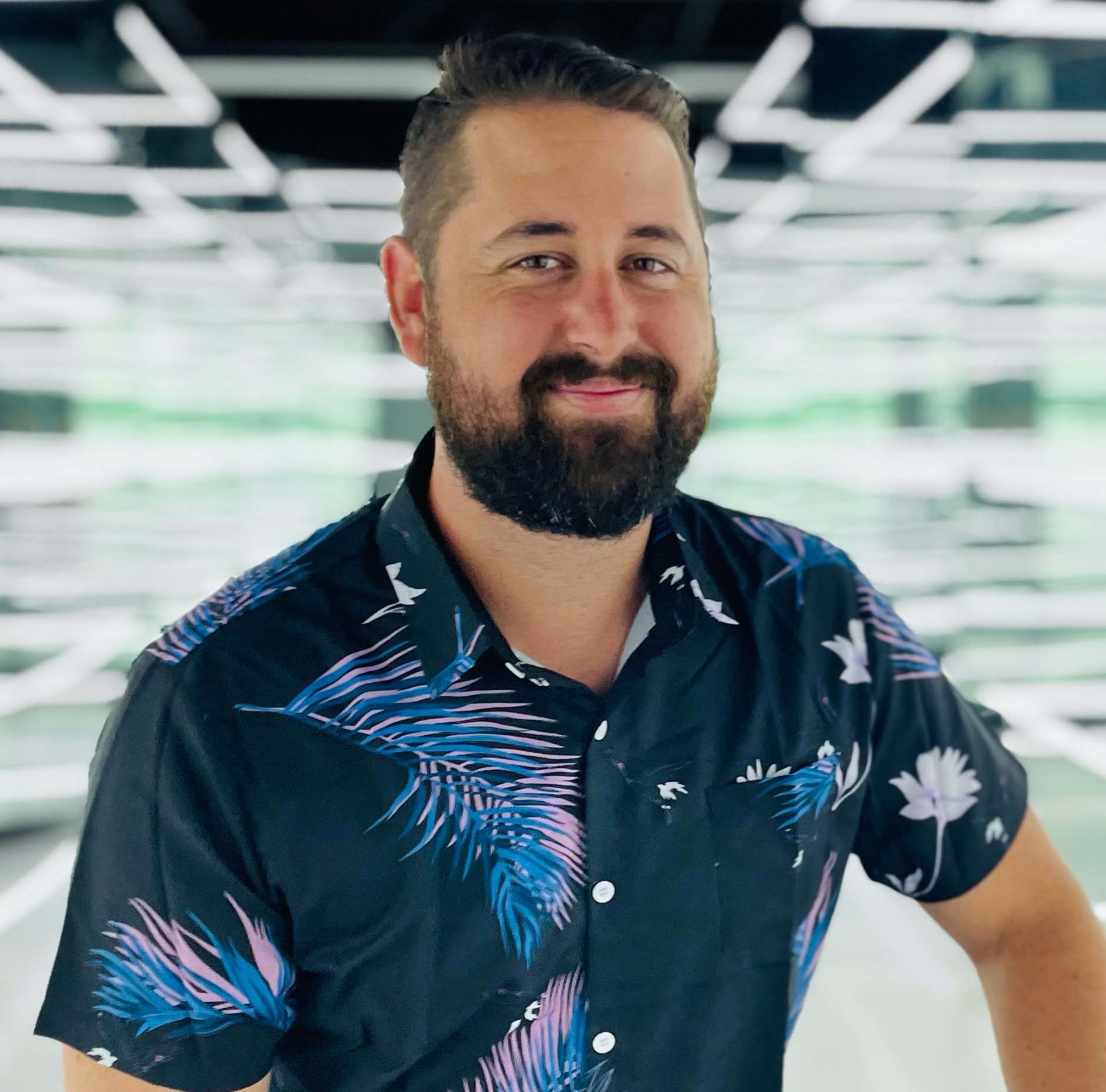Today’s guest is Preston Zeller, and I’m excited for you to meet him and hear his story.
I was immediately interested in learning more about his grief journey as a creative person. And what I found out about his story makes me think a higher power wanted us to meet. Our stories of loss and grief are very similar in that we’ve both suffered sibling loss, both wanting to do something meaningful with our grief by helping others.
Preston is an artist with accomplishments across multiple mediums, including film, photography, music, and fine art. Following the death of his brother in 2019, Preston set out to paint for a year straight to process his grief and share the experience along the way to stir conversation about how we deal with grief in society. The 365 paintings, which create a 10×20′ mosaic, are the subject of a feature-length documentary entitled, The Art of Grieving.
Preston now helps others through grief by creating commemorative paintings using the ashes of a loved one. His goal is to normalize grief conversations and proliferate healthy ways of dealing with grief.
Here are three reasons why you should listen to the complete Episode:
- Preston talks about his 365-project and the representation of his journey through grief.
- He offers valuable insights on the importance of normalizing conversations around grief.
- Find out what he hopes to achieve by sharing his documentary, The Art of Grieving.
Episode Highlights
Who is Preston Zeller
- Preston is an artist with accomplishments across multiple mediums.
- Following the death of his brother, Preston set out to paint for 365 days to process his grief, while sharing the experience along the way.
- He helps families in grief commemorate their loved ones, using ashes in an original abstract painting.
- His mission is to proliferate healing through art while promoting healthy conversations about grief in society and culture.
Sibling grief
- In February 2019, Preston’s brother passed away suddenly.
- Through his own experience and searching the internet, he discovered that sibling grief is overlooked.
The start of the 365 project
- Preston was an artist before his brother passed away.
- He turned to painting to process the grief by creating a long project that was very intentional.
- For 365 days in a row, he’d paint an 8×10″ piece each day, eventually creating a huge mosaic piece of 10×20′.
The representation of how he moved through grief
- A wall in the house he and his wife bought was perfect for what would eventually become this huge artwork.
- He didn’t want to wait to hang all the pieces, so he convinced his wife to turn it into a film set.
- He documented the creative process of what was a representation of how he moved through grief.
Emotions during the process
- There were certain days when he felt energized by painting and days when he felt drained.
- It depended on where he was personally and mentally.
- He didn’t diarize the emotional rollercoaster. Instead, each daily painting was a representation of how he was feeling.
- This often came through in the use of colors.
The use of ashes in his final painting
- Preston had a thought to use his brother’s ashes.
- It was the only painting where he preconceived what he wanted to do. The rest of the pieces were spontaneous.
- The eyes are a common theme in many artistic pieces, especially for someone who deals with addiction.
- He chose to use the ashes in the eye, and it was a very appropriate way to cap off all the paintings.
The process of helping others
- Helping others commemorate their loved ones has been a rewarding process for Preston.
- When he meets with someone, he goes through memory exercises to understand how they want to remember their loved one.
- By showing techniques, he gets a good idea of what they gravitate towards and what they find striking.
- He does progress check-ins before delivering the final piece of art.
Benefits of a commemorative painting
- Generally, people keep ashes, scatter them or bury them.
- Scattering them creates a moment in time while burying them creates a geographically fixed location.
- One can still do any of the above if it’s the final wish, but not all ashes need to be used.
- By creating a commemorative piece of art using some of the ashes, you get to take the piece with you if you move and because it’s abstract, the piece grows with you as grief changes.
The documentary
- Preston studied film and worked in the industry.
- The idea of a documentary came up at the same time of doing a year of painting.
- He knew that painting every day for 365 days would be a trippy process as he journeyed through grief.
- A documentary fell in line with the paintings he wanted to share, helping spark conversation about the grieving process.

The documentary shares his brother’s story
- Preston shares his story in the documentary, it shares his brother’s journey of grief too.
- His brother was in the military and suffered pain and PTSD.
- Instead of VA clinics supporting him to process his grief correctly, he was given a bunch of pharmaceuticals to medicate, leading to addiction.
The underlying message
- By watching the documentary, Preston wants people to feel empowered to do something about their grief.
- The overarching goal is to get people to talk more about grief, to normalize it.
- Also, to proliferate art and creative therapy healing solutions outside of talk therapy.
Normalizing conversations about grief
- Western society glorifies overworking and burnout, and it hasn’t normalized emotional conversations. It’s seen as a weakness.
- People are therefore not equipped to process grief and loss.
- It’s important to shine a spotlight on it, encouraging these conversations and normalizing them.
What’s next for Preston
- Helping people with their grief through paintings of their loved ones.
- Using the documentary as a platform to spread the word, lifting my voice and the voices of others.
- Proliferating conversations on grief is what he will be doing for the rest of his life.

What Preston is grateful for
- That people are enjoying his documentary.
- The ability to get new school materials for his kids as they’re homeschooled.
- He’s grateful for Yahweh (Hebrew name for God) in his life.
3 Powerful Quotes from this Episode
16:25 – “Okay, you know, I want to, I want to do his eye, his eye is this common theme in a lot of art, artistic stuff I did. I mean, you know, especially like, someone who deals with addiction, like, you can look at their eyes and know right away, like, are you on anything? They’ll be like, No, and you look at their eyes. And you’re like, Yeah, you are, you know, the first thing you look at? Yeah, so that was like this constant, constant theme for me. And it just felt, I don’t know, appropriate to put ashes in how I remembered his eye. And it was a very apropos way to me to just cap off all those paintings.”
25:36 – “I didn’t want people to watch this and feel just as depressed as me. I wanted them to feel like they like sort of empowered and that they can do something about their grief. And the real overarching goal is to get people to talk about grief more to see this and go, Oh, this is this, I haven’t experienced this before. I haven’t seen someone do something creative out of grief, or, you know, that kind of thing. And then also proliferate, the use of, you know, solutions, like art therapy, or just even personal creative therapy, in their grief, that you’re not limited to necessarily talk therapy or, or something like that”.
31:14 – “But I realized that I’m like, I’m making this, you know, a documentary about my grief, talking about his story, but it’s talking about his grief as well, because you’re like, that’s a lot of the reason why people use it because they have grief about these things.”
Connect with Preston Zeller
Enjoying the Hard Beautiful Journey podcast?
Click here to follow on Apple Podcasts. While there, please leave a 5-star rating and review, it would mean so much to me! Also, if you haven’t done so already, join the Hard Beautiful Journey community to connect with other like-minded people.
I would love to connect with you on socials, so please give me a follow on:
Thanks for listening,
Tiff
Leave a Reply Cancel reply
This site uses Akismet to reduce spam. Learn how your comment data is processed.

add a comment
+ show comments